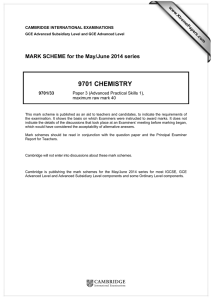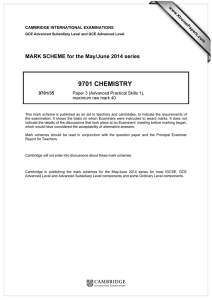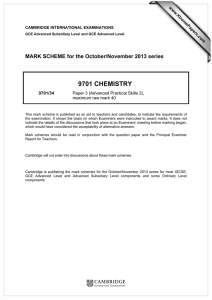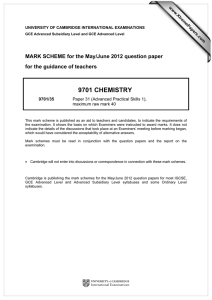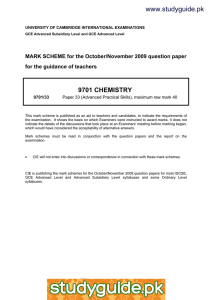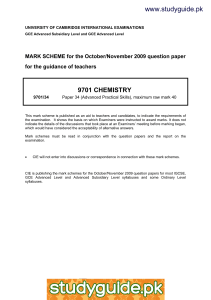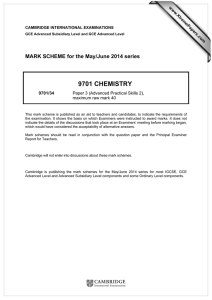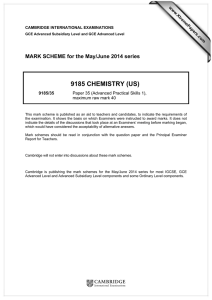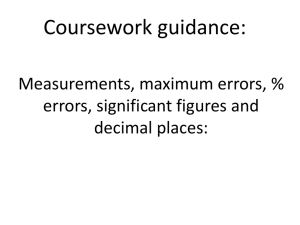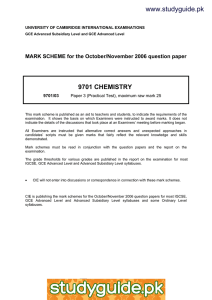9701 CHEMISTRY MARK SCHEME for the May/June 2011 question paper
advertisement
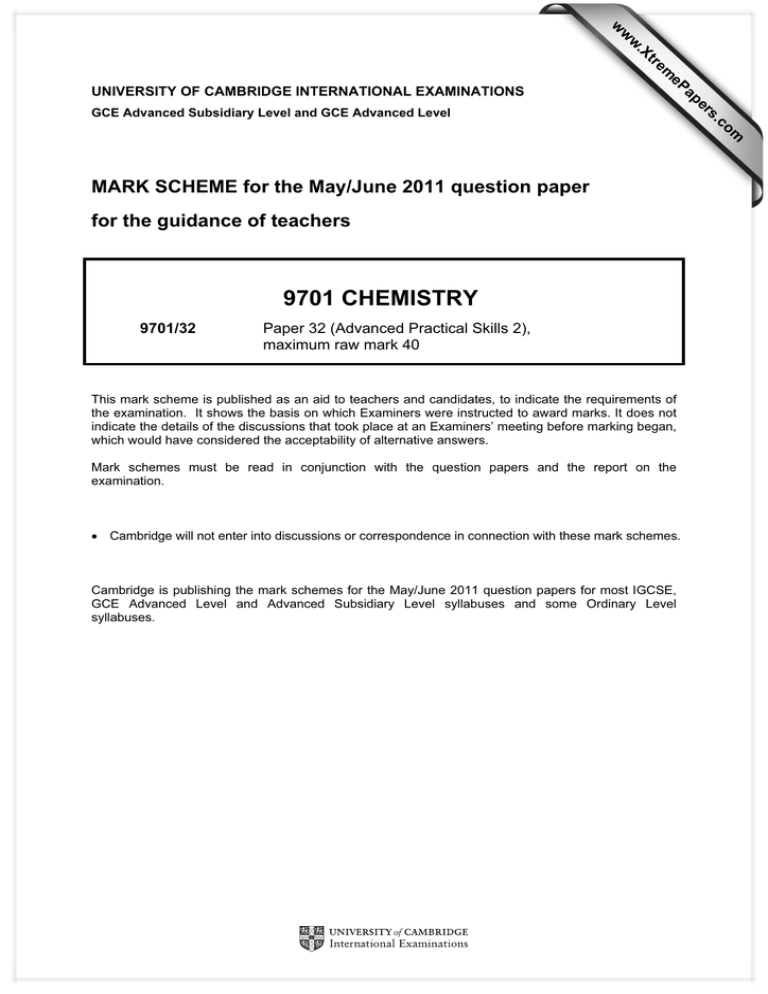
w w ap eP m e tr .X w UNIVERSITY OF CAMBRIDGE INTERNATIONAL EXAMINATIONS for the guidance of teachers 9701 CHEMISTRY 9701/32 Paper 32 (Advanced Practical Skills 2), maximum raw mark 40 This mark scheme is published as an aid to teachers and candidates, to indicate the requirements of the examination. It shows the basis on which Examiners were instructed to award marks. It does not indicate the details of the discussions that took place at an Examiners’ meeting before marking began, which would have considered the acceptability of alternative answers. Mark schemes must be read in conjunction with the question papers and the report on the examination. • Cambridge will not enter into discussions or correspondence in connection with these mark schemes. Cambridge is publishing the mark schemes for the May/June 2011 question papers for most IGCSE, GCE Advanced Level and Advanced Subsidiary Level syllabuses and some Ordinary Level syllabuses. om .c MARK SCHEME for the May/June 2011 question paper s er GCE Advanced Subsidiary Level and GCE Advanced Level Page 2 Mark Scheme: Teachers’ version GCE AS/A LEVEL – May/June 2011 Syllabus 9701 Paper 32 Question Sections Indicative material Mark 1 PDO Layout I Volume given for Rough titre and accurate titre details tabulated. Minimum of 2 × 2 boxes. 1 MMO Collection II Initial and final (burette) (readings) and volume of FB 2 added/reading at start and finish recorded for each accurate titre (not ‘difference’). and mass tube + FB 1, mass tube + residue/empty, mass FB 1. Ignore units. Headings should match readings. Do not award this mark if: 50(.00) is used as an initial burette reading; More than one final burette reading is 50(.00); Any burette reading is greater than 50(.00). 1 PDO Recording III All accurate burette readings (initial and final) recorded to nearest 0.05 (cm3). Assessed on burette readings only (minimum of 2 readings). 1 MMO Decisions IV Has two uncorrected accurate titres within 0.1 cm3. 1 Do not award this mark if, having performed two titres within 0.1 cm3,a further titration is performed that is more than 0.10 cm3 from the closer of the initial two titres, unless a fourth titre, within 0.1 cm3 of any of the previous titres, has also been carried out. (a) Round any burette readings to the nearest 0.05 cm3. Check and correct, if necessary, subtractions in the titre table and in the calculation of mass. Examiner then selects the ‘best’ titre using the hierarchy: two identical; titres within 0.05 cm3, titres within 0.1 cm3 etc. Calculate: candidate’s titre × Supervisor mass to 2 decimal places candidate mass Calculate difference in Supervisor and candidate scaled values and award quality marks as below. MMO Quality V, VI and VII Award V, VI and VII if δ ≤ 0.25 cm3 3 Award V and VI if 0.25 < δ ≤ 0.50 cm3 Award V if 0.50 < δ ≤ 0.80 cm3 If the ‘best’ titres are ≥ 0.60 cm3 apart cancel one of the Q marks. © University of Cambridge International Examinations 2011 [7] Page 3 (b) Mark Scheme: Teachers’ version GCE AS/A LEVEL – May/June 2011 ACE Interpretation Syllabus 9701 Calculates the mean, correct to 2 decimal places from any accurate titres within 0.2 cm3. Paper 32 1 The third decimal place may be rounded to the nearest 0.05 cm3. A mean of exactly .×25 or .×75 is allowed but the candidate may round up to .×3 or .×8 or to the nearest 0.05 cm3. If ALL burette readings are given to 1 decimal place then the mean can be given to 1 decimal place if numerically correct without rounding, Mean of 24.3 and 24.4 = 24.35 () Mean of 24.3 and 24.4 = 24.4 () Titres to be used in calculating the mean must be clearly shown – in an expression or ticked in the titration table. Allow ecf from subtraction error for titre. (c) ACE Interpretation I Correctly evaluates step (i) (= mean titre × 0.2 / 1000) [1] 1 II, III and IV are awarded for the correct expression or for the correct answer if no working shown. For all ‘method’ marks, no additional steps can be included. II Step (ii) (answer to (i) / 2) and step (iii) (answer to (ii) × 10) 1 III In (iv) relative formula mass (= mass of washing soda / answer to (iii)) (ignore g) 1 1 IV In (v) answer to (iv) – 106 / 18 or 106 + 18x = answer to (iv) (mark method even if Mr is < 106 or very large). 1 PDO Display V Some relevant working shown in a minimum of four parts in the calculation (in (ii) could be × 2 or ÷ 2, in (iii) could be × 10 or ÷ 10, in (v) could be use of 106). 1 VI In steps (i) to (iv) all answers to 3 or 4 sig figs (minimum of 3 steps). (d) ACE Interpretation 0.1 × 100 / titre from (b) (only expression needed). [6] 1 [1] [Total: 15] © University of Cambridge International Examinations 2011 Page 4 2 (a) Mark Scheme: Teachers’ version GCE AS/A LEVEL – May/June 2011 Syllabus 9701 PDO Layout I Two balance readings, one mass, two thermometer readings and one change in temperature shown in suitable layout. 1 PDO Recording II Masses and temperatures recorded with correct headings and units for all data shown. Acceptable units for temperature are / oC, (oC), temperature in degrees Celsius, temperature in o C., units for mass are /g, (g), mass in grams. 1 III All thermometer readings recorded to 0.0 oC or 0.5 oC and all balance readings recorded to same degree of accuracy. Round all thermometer readings to nearest 0.5 oC.Check and correct, if necessary, subtractions in the temperature change and the mass used. Supervisor mass Calculate to 1 decimal place: candidate temperature change × candidate mass used Calculate difference in candidate and Supervisor scaled values and award quality marks as below. MMO Quality IV and V PDO Recording (b) (i) ACE Interpretation Award IV and V for changes within 0.8 oC of Supervisor Award V for changes > 0.8 but within 1.6 oC of Supervisor I Expression for heat change in (i) = 25 × 4.3 × temperature change from (a) (answer given must correspond to units quoted). 1 2 [5] 1 II (ii) (iii) ACE Conclusions (c) Paper 32 ACE Improvements Expression for moles of washing soda from mass 1 used and Mr from (a) or Mr = 259 or Mr = 286 in (ii) 1 III Correctly evaluates enthalpy change = heat change / (1000 × moles of washing soda) in (iii) (if 1000 not used, must say J). 1 IV Enthalpy change shown as positive and to 3 sig figs. (Answer need not be arithmetically correct). Ignore sig figs (except if approximated to 1 sig fig in rest of question.) Use a more precise thermometer/a thermometer with 1 more accurate calibrations/a thermometer that reads to 0.1 oC or 0.2 oC (a more accurate thermometer/a digital thermometer/thermocouple is insufficient) or use a more precise method to measure the volume of acid or use a deeper plastic cup or scaling up apparatus and quantities of chemicals used (Do not accept ‘add a lid’) © University of Cambridge International Examinations 2011 [4] [1] [Total: 10] Page 5 Mark Scheme: Teachers’ version GCE AS/A LEVEL – May/June 2011 Syllabus 9701 Paper 32 FB 5 is MgSO4(aq); FB 6 is Pb(NO3)2(aq) FB 7 is Al2(SO4)3(aq); FB 8 is (NH4)2FeSO4(aq) 3 (a) (i) MMO Decisions I Reagents chosen KI(aq) or HCl(aq) or K2CrO4 or K2Cr2O7 or H2SO4 and NaOH (aq) (penalise additional reagents) 1 MMO Collection II NaOH white precipitates for all 1 III Excess NaOH no effect FB 5, precipitate dissolves FB 6 and FB 7 1 IV KI / HCl / K2CrO4 / K2Cr2O7 / H2SO4 nothing/no visible reaction for (FB 5 and FB 7), yellow precipitate/white precipitate for FB 6. 1 Ignore observations for additional reagents. (ii) ACE Conclusions [4] I FB 5 contains Mg2+, FB 6 contains Pb2+ and FB 7 contains Al3+ (no ecf and must follow observations in (i)) 1 II FB 5 (white) precipitate with NaOH, insoluble in excess 1 III FB 6 (yellow) precipitate with KI / (yellow) precipitate with K2CrO4 or K2Cr2O7 / (white) precipitate with HCl or H2SO4. 1 FB 7 No precipitate with KI / HCl / H2SO4 and (white) precipitate with NaOH, soluble in excess. (Both observations needed unless FB 6 already identified as Pb2+). 1 Allow ecf, based on candidate’s observations, for II, III and IV. © University of Cambridge International Examinations 2011 [4] Page 6 Mark Scheme: Teachers’ version GCE AS/A LEVEL – May/June 2011 Paper 32 Effervescence/bubbles/hydrogen produced (ignore any test for ammonia but tests for other gases negate). (Do not accept gas produced) or Black/grey solid/coating on magnesium 1 (ii) Ammonia/gas turns litmus paper blue 1 (iii) Green precipitate (any qualified green including grey/green but do not allow green/brown.) 1 Turns brown (any qualified brown) on addition of hydrogen peroxide. Allow rusty or orange/brown precipitate but not orange alone. Ignore effervescence. 1 Fe2+ / iron (II). 1 (+)2 to 0 (ecf on chromium (+)3 to 0) or (+)3 to (+)2). 1 (+)2 to (+)3. 1 (b) (i) MMO Collection Syllabus 9701 ACE Conclusions Conclusions are free standing but must be Fe2+. [5] [2] [Total: 15] © University of Cambridge International Examinations 2011

